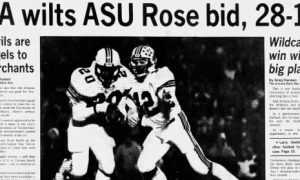[ezcol_1half id=”” class=”” style=””]

SERIES LINKS
— General history
— Comparisons then and now
[/ezcol_1half]
[ezcol_1half_end id=”” class=”” style=””]
Excerpt from L.A. Times, Nov. 8, 1914, authored by Bill Henry:
“Arizona’s cactus-fed athletes, despite heroic efforts on the part of their two halfbacks, (Asa) Porter and (Franklin) Luis, went down to defeat before the Occidental Tigers yesterday afternoon, the tally with all precincts heard from being 14 to 0 in favor of the Tigers.
Confident of rolling up a big score, the Tigers took the field with grins on their faces, but before the game was 10 seconds old they knew they had a battle on their hands.
The Arizona men showed the fight of wild cats and displayed before the public gaze a couple of little shrimps in the backfield who defied all attempts of the Tigers to stop them.”
This site will conduct a countdown in a 100-day period, leading up to Arizona’s 2014 football season-opener with UNLV on Aug. 29 at Arizona Stadium. The 100 Days ‘Til Kickoff countdown will include information daily about the historic 1914 Arizona team that helped create the school’s nickname of “Wildcats” because of how they played that fateful day against Occidental.
[/ezcol_1half_end]
Before the 1914 football team, John “Button” Salmon, Douglas Holdsclaw and Jack Lee — iconic figures who contributed to revered traditions at Arizona — there was Quintus J. Anderson.

John “Button” Salmon became part of Arizona lore 12 years after the 1914 team made history
Never heard of him? Anderson was the student manager of Arizona’s first football team in 1899 responsible for changing the school colors from sage green and silver to cardinal red and navy blue.
The 1914 football team is responsible for Arizona’s nickname of “Wildcats”.
Salmon, student body president and team captain as quarterback, uttered the famous words “Tell them … tell the team to bear down” on his death bed to coach J.F. “Pop” McKale before the season ended in 1926.
“Bear Down” became the school’s slogan. Members of the Arizona student body painted the slogan on the roof of the university gymnasium, which became known as Bear Down Gym. An airplane view of that huge-lettered phrase caught the view of Lee, the school’s long-time band director.
Lee, an assistant marching band director at Michigan, wrote the fight song, “Bear Down, Arizona” during his return flight to Ann Arbor, Mich., following his job interview in 1952. He was hired as Arizona’s band director and served in that capacity for 33 years.

The 1914 Arizona football team to earn the honor of being named the first “Wildcats” was composed of (front row, left to right): Verne La Tourette, George Seeley, Leo Cloud, Richard Meyer, Asa Porter. Second row: Franklin Luis, Lawrence Jackson, Ray Miller, J.F. “Pop” McKale (coach), Turner Smith, Harry Hobson (manager), Orville McPherson, Albert Crawford, Ernest Renaud. Back row: Albert Condron, Emzy Lynch, Charley Beach, Vinton Hammels, Bill Hendry, George Clawson, Harry Turvey.
(AllSportsTucson.com graphic/Photo from University of Arizona Library Special Collections)
While the 1914 football team, Salmon and Lee are synonymous with Arizona’s traditions, few know of Holdsclaw and Anderson.
Holdsclaw, a 1925 Arizona grad who later became a lifetime community leader in Tucson, wrote Arizona’s original fight song, “Fight! Arizona! Fight!” in 1929. The song is played as fervently by the band as “Bear Down, Arizona” at sporting events.
A misnomer about Arizona’s traditions is the school colors were sage green and silver through the Salmon era.
The 1914 Arizona football team wore the cardinal red and navy blue when they became dubbed “Wildcats” 15 years after the efforts of Anderson.
Before coach Stuart Forbes’ team played Arizona’s first game against Tucson Town in 1899, Anderson struck a deal with a local merchant for solid blue game sweaters with red trim. School officials granted Anderson the change in colors. Cardinal red and navy blue has been worn by Arizona athletes since.

The cardinal red leggings worn by the 1914 Arizona football team include a navy blue stripe
The school newspaper was known Sage Green and Silver when it was founded in 1899 before the first football game. The publication changed to Arizona Weekly Life shortly thereafter. It was also called Arizona Life and University Life. It is now called the Arizona Daily Wildcat.
Why sage green and silver before the change to cardinal red and navy blue? Sage was in reference to the indigenous sage bush and silver symbolizing the state’s mining industries. An editorial in the school newspaper declared, “We think those colors well chosen, as they show originality and individuality.”
A year later after Anderson’s purchase of the blue sweaters with red trim, the November 1900 issue of the school newspaper included an editorial suggesting that the combination of sage green and silver had “outgrown its usefulness.” The writer asserts that school colors should produce a decorative college pin, flag or varsity sweater and the sage and silver failed to do so.
The December issue that year reported that a committee was selected to review school colors. The students almost unanimously adopted cardinal red and navy blue as the new school colors.
ALLSPORTSTUCSON.com publisher, writer and editor Javier Morales is a former Arizona Press Club award winner. He also writes articles for Bleacher Report and Lindy’s College Sports.
[rps-paypal]
|
|




























